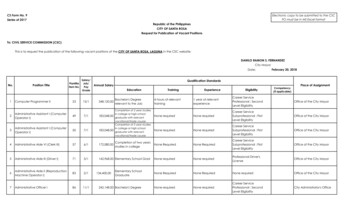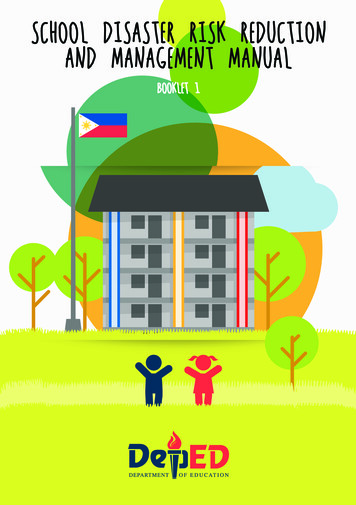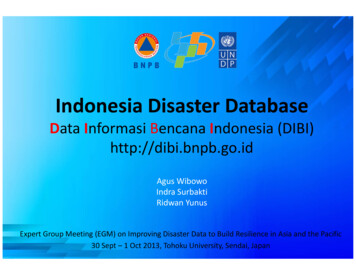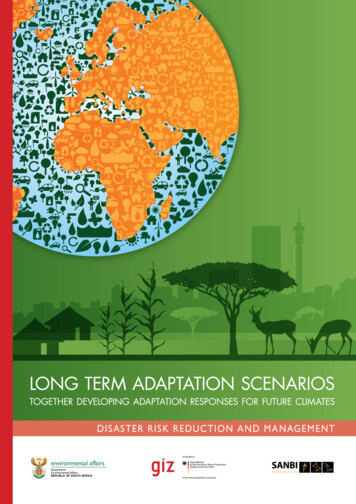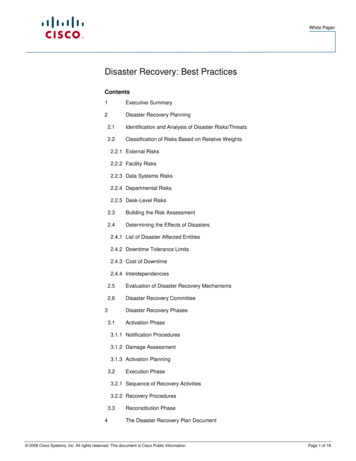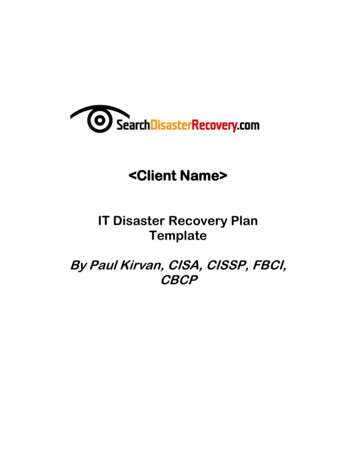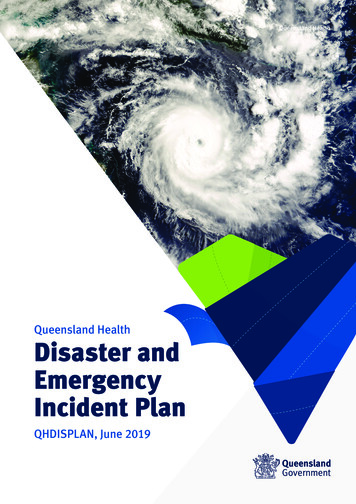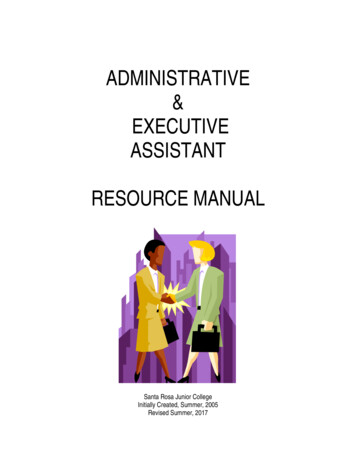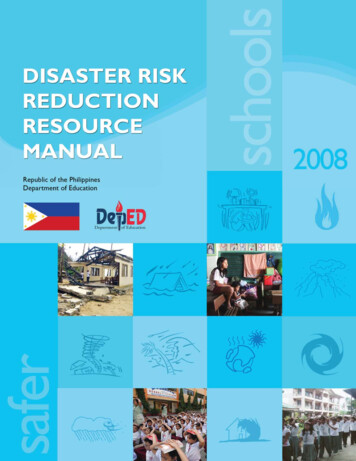
Transcription
DisasterRiskReductionResourceManual
AcknowledgmentsT h e Te c h n i c a l Wo r k i n g G r o u p ( T W G ) o n D i s a s t e r P r e p a r e d n e s s o f t h eDepartment of Education (DepED) gratefully acknowledges the invaluable help attributed to severalpersonnel of the DepED family in the realization of this publication. Heartfelt thanks are also due togovernment agencies for providing the task force information, photo and graphic presentations toillustrate scientific and technical aspects of destructive occurences of the environment.These agenciesare: the Department of National Defense (DND) through the National Disaster Coordinating Council(NDCC); the Philippine Institute of Volcanology and Seismology (PHIVOLCS); the Philippine AtmosphericGeophysical and Astronomical Services Administration (PAGASA); and the Office of Civil Defense(OCD).Our particular thanks go to Honorable Jesli A. Lapus, DepED Secretary, for pushing vigorously the TWGto come up with a resource manual that will reduce, if not eliminate, the loss of lives and properties asa result of natural or human made / induced disaster.We are equally grateful to Undersecretary TeodosioC. Sangil, Jr. for inspiring and facilitating the financial requirements in the development of this project. Department of Education (DepED)2008PhilippinesDisaster Risk Reduction Resource Manual(Safer Schools Resource Manual)Published by the Department of Education (DepED) Philippines inpartnership and with the support of the United Nations Children’sFund (UNICEF) PhilippinesPrinted in collaboration with Plan International Philippines.Special thanks to the Office of the Civil Defense (OCD) in Central Visayas, especially to Mr. andMrs. Angel Gaviola for their inputs, and constructive comments during the plenary sessions, andregional directors, division superintendents and some school heads, that provided information andre c o m m e n d a t i o n s t h a t h e l p e d v a l i d a t e t h e ve r a c i t y a n d a u t h e n t i c i t y o f t h i sendeavor.We also thank the United Nations Children’s Fund (UNICEF) for all their efforts in making this manual areality through the provision of funds for the final printing of the manuscript,and its support through the services ofM r. R o b i n W i l l i s o n ( C o n s u l t a n t ) , M s . V i c ky E l e e n C a t a d m a n ( L ayo u t A r t i s t ) , a n dMr. Jason Villena (Illustrator). We also thank Plan Philippines through Mr. BaltazarTr i b u n a l o J r . , C o u n t r y P r o g r a m A d v i s o r o n D i s a s t e r R i s k R e d u c t i o n , f o rproviding inputs as well as funds for the printing of the final draft of this manual.This manual was prepared by the Technical Working Group, created through DepED Memo No. 175 s.2007, on the preparation of DepED Calamity, Disaster and Risk Management and Control OperationsManual. The complete list of the members of the Technical Committee and those others involved inthe development of the manual can be found in Annex 6.Disaster Risk Reduction Resource Manualiii
MessageMessageI wish to congratulate the Depar tment’s Technical WorkingG ro u p ( T W G ) o n t h e p re p a r a t i o n o f t h e D i s a s t e r R i s kReduction Resource Manual led by Undersecretary Teodosio C.Sangil, Jr.,Writers from the Bureau of Elementary Education (BEE),Bureau of Secondary Education (BSE), and the AudioVisual Division, Office of theTechnical Service;all the Consultants from the Land Bank of the Philippines;Officeof the Civil Defense (OCD), Department of National Defense; Department ofScience and Technology (DOST) through the Philippine Atmospheric,Geophysical and Astronomical Services Administration (PAGASA), PhilippineInstitute of Volcanology and Seismology (PHIVOLCS); Philippine National RedCross (PNRC); United Nations Children’s Fund (UNICEF); and the centralsecretariat from the Office of the Director,Administrative Service, for puttingtogether their hearts, minds and efforts in order to come up with a readyreference and resource manual on disaster risk reduction.Saving lives and properties is a challenge accepted by all stakeholders inprivate and governmental entities. As such, aside from the business ofproviding basic education, the Department of Education is responsible forproviding safe teaching-learning facilities and hazard-free environment tothe schoolchildren.I am pleased to convey my warm greetings to the Technical WorkingGroup, the writers, the Consultants, and the officials and employees of theDepartment for having developed the Disaster Risk Reduction ResourceManual of the Department of Education.This Manual significantly provides valuable information for the schoolcommunity’s safety amidst the impending threats of natural and manmadehazards and disasters. It specially provides the schoolchildren with keymessages so that they can cope with the threats of disasters especially inschool.It is hoped that, through this Manual, our officials in the Department will beencouraged to take further initiatives to meet the challenges of their tasks,and enhance their collective services and professional concerns.The readingpublic, on the other hand, will know that the department is truly workingtowards an efficient and caring educational system.Congratulations!This manual, therefore, has been developed to make the Principals, SchoolHeads,Teachers and School Personnel aware, alert and vigilant of the hazards,what to do before, during and after their occurence, in order to reduce theirdamages and impact to lives and properties.I hope that this Manual will be useful and beneficial to all.Teodosio C. Sangil, Jr.Undersecretary of theDepartment of EducationJesli A. LapusSecretary of theDepartment of EducationivDisaster Risk Reduction Resource ManualDisaster Risk Reduction Resource Manualv
ContentsMessageThe Philippines is considered one of the most disaster-prone countries.Every year, storms, flash floods, landslides, earthquakes, and volcanic activities batter the country. In disaster or emergency situations, children arevery vulnerable to illness and trauma and require special care and attention.During these trying moments, schools offer safety and shelter to thosedisplaced by disasters.Schools, however, should not only offer safety after a disaster has struck.Our schools should also be ready even before any disaster strikes. Ourteachers, school officials, and school children should learn basic life-savingtips. Our schools should be a beacon of safety, and should be an exampleto the communities which they serve.The United Nations Children’s Fund (UNICEF) is pleased to support thedevelopment of this Disaster Risk Reduction Resource Manual. We, atUNICEF, hope that the Department of Education and the whole Philippineschool system will use this resource manual to preserve life and health, andmake our communities safer for our children.Acknowledgments .iiiMessages.ivIntroduction.1How to Use this Resource Manual .2Acronyms.3Glossary of Terms nessa J.TobinRepresentativeUnited Nations Children’s FundPhilippines Country OfficeOverview of Disaster Risk Reduction . 11Natural Hazards . 20Hydro-Meteorological Phenomena and Hazards . 21Geological Phenomena and Hazards . 33Human Induced Hazards . 41Technological Hazards . 41Environmental Hazards .47Socio-economic, Political, Security Hazards . 48Risk Profile of the Philippines . 51The Philippine Disaster Risk Management System . 60Ensuring Continuity of Instruction . 95Ensuring Safety of DepED Properties . 104Monitoring & Evaluation of the Disaster RiskManagement Implementation. 115History of Natural and Man-made Incidentsin the Philippines . 136The Incident Command System . 144Critical Incident Stress Debriefing . 150NDCC Memorandum and DepED Orders . 153How to Read Maps. 162Technical Committee . 167Emergency Numbers . 168Resources. 170viDisaster Risk Reduction Resource ManualDisaster Risk Reduction Resource Manualvii
viiiDisaster Risk Reduction Resource Manual
IntroductionDisaster Risk Reduction ResourceManual (Safer Schools Resource Manual)The Department of Education, as mandatedby the Constitution is primarily responsible forthe education and manpower development ofthe country and for the formulation, planning,implementation and coordination of the policies,plans, programs and projects in the areas of formal,informal, and non-formal education at theelementary, secondary and the alternative learningsystem. This mandate also includes supervisionof all basic educational institutions, both publicand private, as well as the establishment andmaintenance of a complete, adequate andintegrated system of education.The Department is in charge of raising thestandard of basic education and administrativeefficiency in the delivery of educational servicesthat are relevant and in pursuance to the nationaldevelopment goals.The Department, as providerof basic education, serves 17 million schoolchildren (School Year 2007-2008) and envisionshighly competent, civic-spirited, life skilled andGod-loving Filipino youth who will be the futurecontributor towards the building of a humane,healthy and productive society.The destructions brought about by the seriesof typhoons that swept our country in 2006resulted in damage to 5,600 schools in SouthernDisaster Risk Reduction Resource ManualLuzon with estimated cost at about PHP 3.1billion and affected about 8 million schoolchildren in both elementary and secondaryschools. Those destructive fortuitous events,prompted educational authorities to prepareand adopt this Safer Schools Resource Manual toguide education officials, school administrators,teachers and eventually the schoolchildren onwhat to do before, during and after the onslaughtof any hazard, in order to reduce its disastrousimpact and damages.This Manual of the Department of Educationis based on the Hyogo Framework for Action,a 10-year plan to make the world safer fromnatural hazards. This was formulated during theWorld Conference on Disaster Reduction heldin Kobe, Hyogo, Japan, January 2005.The Hyogo Framework is a global blueprintfor disaster risk reduction efforts during the nextdecade. Its goal is to substantially reduce by 2015disaster losses in lives, and in the social, economic,and environmental assets of communities andcountries. It also offers guiding principles,priorities for action, and practical means forachieving disaster resilience for vulnerablecommunities.1
AcronymsHow To Use This Resource ManualThe Manual is for school administrators,supervisors and school teachers, to provide themwith information needed to reduce risk and makeschools safer. The Department of Education(DepED) through the Technical Working Group(TWG) of the Department’s Disaster RiskReduction Management conceptualized thepromotion of hazard/disaster awareness,to manage impacts, and to help all schoolcommunities to reduce the risk of threats fromnatural and human-made/induced disasters.of a program is always an issue, so, provisionof the monitoring, evaluation, and properreporting procedures ensures the continuityand effectiveness of the implementation of theDisaster Risk Management Program.The ultimate goal of this resource manualis to protect the lives of the members of theschool community and property. Every schoolpersonnel must: This resource manual provides proceduresbased on the policy statement of the Departmentof Education for the empowerment of DepEDpersonnel. It outlines the legal bases of the programand spells out the role of the Department’sCentral Office, Regional Offices, Division Offices,down the school level. The adopted 4-phasestrategy: Mitigation, Preparedness, Response, andRehabilitation, illustrates the basic proceduresthat a school may employ before, during andafter the occurrence of a disaster. This manualoffers safeguarding mechanisms to protectand preserve personnel and students, DepEdproperty, school facilities, equipment, fixtures,instructional materials and school records.Alternative learning system as well asrehabilitation of learning venues is furtherpredetermined to ensure continuity of instruction.This is to carry out the duties and responsibilitiesof the school to deliver instruction even intimes of emergencies or calamities. Sustainability2 Analyze the condition of the school orconduct situational analysis;Identify possible hazards/threats faced bythe school;Follow and strictly act according to thedisaster management strategies especiallyin times of emergencies, calamity/disaster;Provide feedback to the authorities forpolicy formulation; andRequest the DepED Division/Regional/Central Offices / other localand international GOs, NGOs andstakeholders for any assistance.To effectively achieve the expectedresponse in times of emergency and calamity,school officials and other personnel must taketime to understand the contents of this SaferSchools Resource Manual, practice and internalizethe risk reduction measures to eventually make ahabit of being prepared before, during and aftera calamity, be it a natural or a human-made /induced hazard.Disaster Risk Reduction Resource PDMSAlternative Delivery ModeAssistant School Division SuperintendentAssociation of Structural Engineers of the PhilippinesBasic Education Information SystemBoy Scouts of the PhilippinesCalamity, Disaster and Fire Control GroupCritical Incident Stress DebriefingDamage Assessment and Needs AnalysisDepartment of Environment and Natural ResourcesDepartment of EducationDistance Learning ModulesDisaster Operation CenterDepartment of Science and TechnologyDisaster Risk ReductionDisaster Risk Reduction GroupDisaster Risk Reduction Management OfficeDisaster Risk Reduction Resource ManualDisaster Risk Reduction ProgramDepartment of Social Welfare and DevelopmentEmergency Operation CenterGovernment OfficeGovernment Procurement Policy BoardGirl Scouts of the PhilippinesIncident Command SystemLocal Disaster Coordinating CouncilLetter of InstructionMedium Term Development PlanNational Mapping and Resource Information AuthorityNational Aeronautics and Space AdministrationNational Calamities and Disaster Preparedness PlanNational Disaster Coordinating CouncilNational Disaster and Calamities PlanNon-Government OfficeNational Oceanographic and Atmospheric AdministrationOffice of the Civil DefensePhilippine Atmospheric, Geophysical, Astronomical Services AdministrationProvincial Disaster Coordinating CouncilPhilippine Disaster Management SystemDisaster Risk Reduction Resource Manual3
TEEPTMGTWGPhysical Facilities and Schools Engineering DivisionPhilippine Institutes of Volcanology and SeismologyPhilippine Institute of Civil EngineersPhilippine National Red CrossParalytic Shellfish PoisoningRegional DirectorRegional Disaster Coordinating CouncilSchools Division SuperintendentSecondary Education Development and Improvement ProjectSchool Mapping ExerciseSafer Schools Resource ManualRapid Damage Assessment ReportsThird Elementary Education ProjectTechnical Management GroupTechnical Working GroupGlossary of TermsAdvisory. A report giving notification, information or message containing recommendations on whatactions are to be undertaken.Alternative Learning System. A parallel learning system that provides a viable alternative to theexisting formal education instruction. It encompasses both the nonformal and informal sources ofknowledge and skills.Asteroid. Any of numerous small celestial bodies that revolve around the sun, with orbits lying chieflybetween Mars and Jupiter and characteristic diameters between a few and several hundred kilometers.Also called minor planet, planetoid.Atmospheric. Of, relating to, or existing in the atmosphere. Produced by, dependent on, or comingfrom the atmosphere. Resembling or representing the atmosphere; having or giving the effect oftranslucence: a painting suffused with a hazy, atmospheric glow. Intended to evoke a particular emotionaltone or aesthetic quality: lush atmospheric touches in every room.Caldera. A large crater caused by the violent explosion of a volcano that collapses into a depression.Capability. Qualitative assessment of human and material resources such as ability,competence, authority.Capacity. Quantitative assessment of human and material resources. Example: number, volume, size.Capacity Building. Efforts aimed to develop human skills or societal infrastructures within acommunity or organization needed to reduce the level of risk.Comet. A celestial body moving about the sun, usually in a highly eccentric orbit, consisting of a centralmass surrounded by an envelope of dust and gas that may form a tail that streams away from the sun.Complex Emergency. Form of man-made emergency in which the cause of the emergency as wellas the assistance to the afflicted is complicated by intense levels of political considerations.Contingency Planning. Forward planning process, in a state of uncertainty, in whichscenarios and objectives are agreed, managerial and technical actions defined, and potential responsesystems put in place in order to prevent, or better respond to, an emergency or critical situation.Counter Measures. All measures taken to counter and reduce disaster risk. They most commonlyrefer to engineering (structural) measures but can also include non-structural measures and toolsdesigned and employed to avoid or limit the adverse impact of natural hazards and related environmentaland technological disasters.4Disaster Risk Reduction Resource ManualDisaster Risk Reduction Resource Manual5
Disaster Impact. Actual hazard event or its immediate consequences requiring extraordinaryresponse.Disaster Mitigation. An act of preventing or minimizing the adverse effects of disaster-causingphenomena through the introduction of measurers designed to prepare and protect life and propertyof the members of the society before the occurrence of a phenomenon. Mitigation includes activitiesthat prevent a disaster, reduce the chance of a disaster from happening, or reduce the damagingeffects of unavoidable natural phenomena. Construction of typhoon-resistant or earthquake-resistanthouses and other structures and locating human settlements away from high risk areas are examplesof mitigation activities.Disaster Preparedness. A state in which individuals and groups of a community have developedplans, allocated resources, and established procedures for an efficient and effective implementation ofthe plans for the purpose of saving lives and preventing further damage to property in the event of adisaster. Preparedness includes plans or preparations made to save lives and to help response-andrescue operations. Evacuation plans and stocking food and water are both examples of preparedness.Disaster Risk Management The systematic process of using administrative decisions, organization,operational skills and capacities to implement policies, strategies and coping capacities of the societyand communities to lessen the impacts of natural hazards and related environmental and technologicaldisasters. It comprises all forms of activities, including structural and non-structural measures to avoid(prevention) or to limit (mitigation and preparedness) adverse effects of hazards.Early Warning. Process of information gathering and policy analysis to allow the prediction ofdeveloping crises and action either to prevent them or contain their effects.Earthquake. A feeble shaking to violent trembling of the ground produced by the sudden displacementof rocks or rock materials below the earth’s surface.Ecologists. A specialist in the scientific study of living things in relation to each other and to theirenvironment.El Nino-Southern Oscillation (ENSO). A complex interaction of the tropical Pacific Ocean andthe global atmosphere that results in irregularly occurring episodes of changed ocean and weatherpatterns in may parts of the world, often with significant impacts, such as altered marine habitats, rainfallchanges, floods, droughts and changes in storm patterns.Emergency. Any situation in which the life or well-being of a community will be threatened unlessimmediate and appropriate action is taken, and which demands an extraordinary response andexceptional measurers.Fissuring. A movement in the ground causing a narrow opening produced by cleavage or separationof parts.glossary of termsglossary of termsgDisasters. Natural or man-made emergencies that cannot be handled by affected communities whoexperience severe danger and incur loss of lives and properties causing disruption in its social structureand prevention of the fulfillment of all or some of the affected community’s essential functions.Flood. The inundation of land areas which are not normally covered by water. A flood is usuallycaused by a temporary rise of the water level of a river, stream or other water course, inundatingadjacent lands or flood-plains. It could also be due to a temporary rise of lakes, oceans or reservoirsor other bodies of water inundating border lands normally above water.Flood Plain. A flat or nearly flat surface that may be submerged by flood waters.Forecast. To tell in advance what is likely to happen. In weather forecasting, to tell the calculatedfuture weather situation within a specific period of time for a given area.Geographic. Pertains to geography or to the natural features, population, industries, etc. of a regionor regions.Geological Hazard. Natural earth processes or phenomena that may cause the loss of life or injury,property damage, social and economic disruption or environmental degradation.Geotechnical. Pertains to the practical applications of geological science in civil engineering, mining, etc.Geomagnetic Storms. Major disturbances of the magnetosphere that occur when the interplanetarymagnetic field turns southward and remains southward for a prolonged period of time.Hazard. Any phenomenon that has the potential to cause disruption or damage to humans and theirenvironment. Or an event or occurrence that has the potential for causing injury to life, propertyand environment.Heat Wave. Prolonged period of excessive heat, often combined with excessive humidity. PAGASAsteps up its procedures to alert the public during these periods when it anticipates an increase inhuman heat-related illnesses.Heat Index. A number in degrees Celsius (C) that tells how hot it really feels when relative humidityis added to the actual air temperature. Exposure to full sunshine can increase the heat index by 15degrees.Heat Cramps. Heat cramps are muscular pains and spasms due to heavy exertion.Although heat cramps are the least severe, they are often the first signal that the body is having troublewith the heat.Heat Exhaustion. Heat exhaustion typically occurs when people exercise heavily or work in a hot,humid place where body fluids are lost through heavy sweating. Blood flow to the skin increases, causingblood flow to decrease to the vital organs. This results in a form of mild shock. If not treated, thevictim’s condition will worsen. Body temperature will keep rising and the victim may suffer heat stroke.Heat stroke. Heat stroke is life-threatening. A person’s temperature control system, whichproduces sweating to cool the body, stops working. The body temperature can rise sohigh that brain damage and death may result if the body is not cooled quickly. Sunstroke isanother term for heat stroke.Hydrology. The study of water on the surface of land, in the soil and underlying rocks, and in theatmosphere, particularly with respect to evaporation and precipitation.6Disaster Risk Reduction Resource ManualDisaster Risk Reduction Resource Manual7g
Informal Education. A lifelong process of learning by which every person acquires and accumulatesknowledge, skills, attitudes and insights from daily experiences at home, at work, at play and from lifeitself.Intensity. The seismic effect of an earthquake at a given place on man-made structures and on theground itself. Intensity refers to the actual earthquake effects as observed at specific places. It is ameasure of the degree of shaking at any given place. Intensity is dependent on the ground, the depth ofthe epicenter, and structural conditions at a particular area. It varies from place to place. It is highestnear the epicenter and decreases gradually as distance from the epicenter increases.Inter-tropical Convergence Zone. Boundary area between the trade wind system of the Northernand Southern hemispheres characterized in the maritime climates by a showery precipitation withcumulonimbus clouds sometimes extending to great heights.Inundation. The rising and spreading of water over land.La Niña. Approximately the opposite condition to El Niño. Each El Niño or La Niña episode usuallylasts for several seasons.Land Fall. An instant at which the “eye” of a tropical cyclone approaches the land mass portion ofa coastal area.Magnitude. A measure of the energy released in the form of vibration by a particular earthquake.It is measured from seismographic instrument recordings. It is a measure of energy released at thefocus. It is not affected by the distance to the epicenter or ground and structural conditions.Monsoon. The wind blowing from one direction during a certain part of the year, alternating with thewind from the opposite direction in another part of the year.Precautionary Measures. Steps or actions undertaken in advance to avoid hazards.Nonformal Education. Any organized, systematic educational activity carried outside the frameworkof the formal system to provide selected types of learning to a segment of the population.Non-Structural Measures. Refers to policies, awareness, knowledge development, publiccommitment, and methods and operating practices, including participatory mechanisms and the provisionof information, which can reduce risk and related impacts.Oceanography. Pertains to the scientific study of oceans, the life that inhabits them, and theirphysical characteristics, including the depth and extent of ocean waters, their movement and chemicalmakeup, and the topography and composition of the ocean floors. Oceanography also includes oceanexploration. Also called oceanology.Preparedness. Activities and measures taken in advance to ensure effective response to the impactof hazards, including the issuance of timely and effective early warnings and the temporary evacuationof people and property from threatened locations.8Disaster Risk Reduction Resource Manualglossary of termsglossary of termsgHydrometeorology. The study of atmospheric water, esp. precipitation, as it affects agriculture,water supply, flood control, power generation, etc. It pertains to the occurrence, motion, and changesof state of atmospheric water.Prevention. Activities to provide outright avoidance of the adverse impact of hazards and means tominimize related environmental, technological and biological disasters.Pyroclastic Flow. High-density mixtures of hot, dry rock fragments and hot gases that move awayfrom the vent that erupted them at high speeds.They may result from the explosive eruption of moltenor solid rock fragments, or both. They may also result from the nonexplosive eruption of lava whenparts of dome or a thick lava flow collapses down a steep slope.Reconstruction. An activity to bring about higher quality of life and security againstdisaster.gRecovery. Decisions and actions taken after a disaster with a view to restoring or improving thepre-disaster living conditions of the stricken community, while encouraging and facilitating necessaryadjustments to reduce disaster risks.Relief. An act of helping or alleviating the conditions of persons who are suffering from the effectsof disaster.Response. The act of implementing or translating into actions what are called for by thepreparedness plans. Response includes actions taken to save lives and prevent furtherdamage in a disaster or emergency situation. Seeking shelter from strong winds accompanying atyphoon and evacuating to higher grounds due to an impending flood are examples of response.Risk. The expected number of lives lost, persons injured, damage to property and disruption of economicactivity due to natural phenomenon, and consequentl
World Conference on Disaster Reduction held in Kobe, Hyogo, Japan, January 2005. The Hyogo Framework is a global blueprint for disaster risk reduction efforts during the next decade Its g. oal is to substantially reduce by 2015 disaster losses in lives, and in the social, economic
